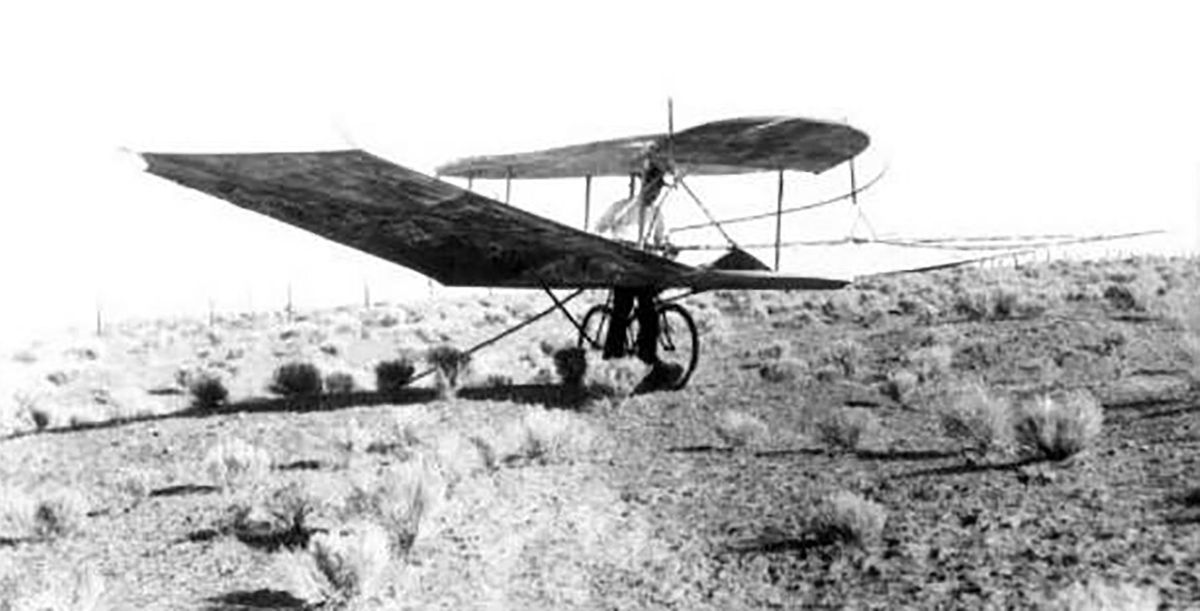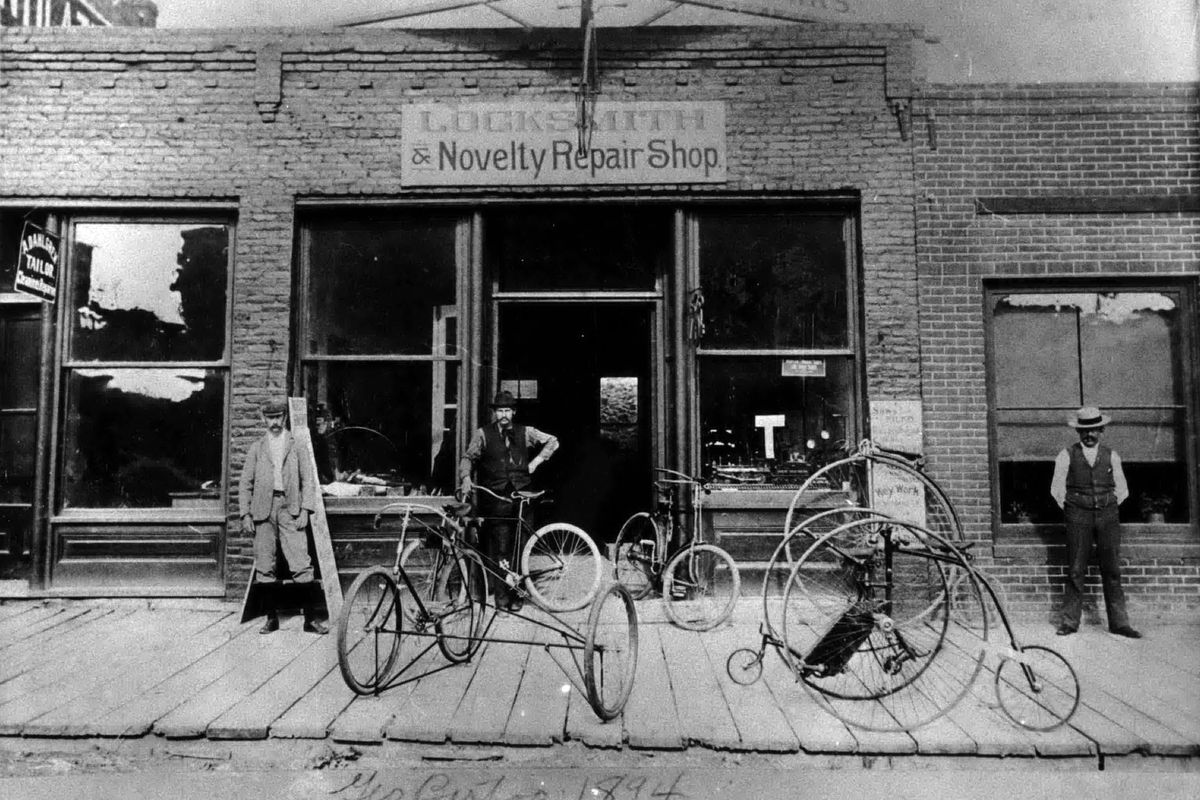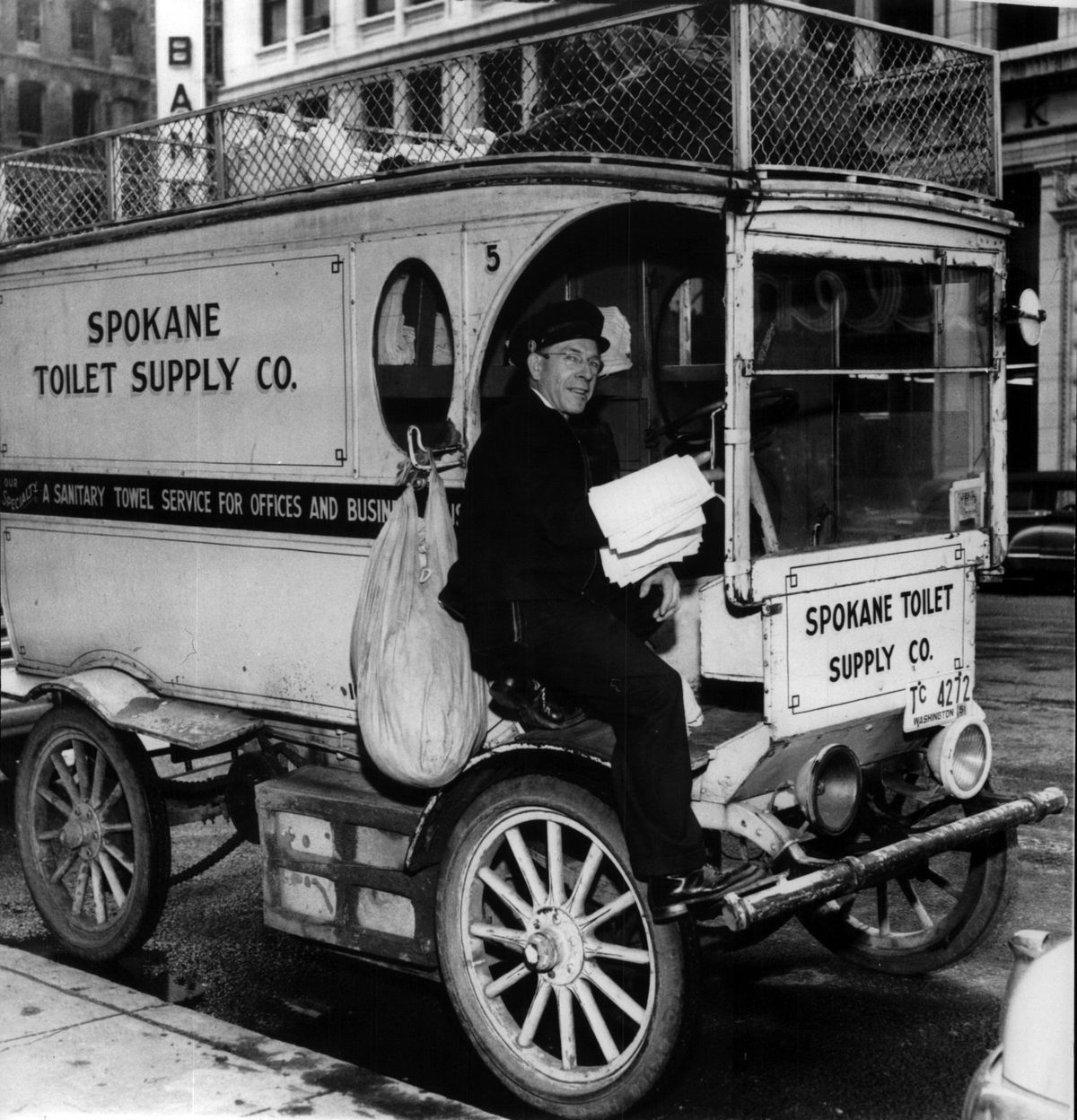Getting There: The weird machines of Spokane’s past
Bartoo & Hall bicycles. S. 101 Howard, circa 1895-96. (The Spokesman-Review photo archive / sr)
Now that Lime and its electric scooters have come and gone, Spokane is back to being overrun with boring, old vehicles. You know the type: Sedans. Trucks. BMX bikes.
Such drudgery is pedestrian, and not in the walking sense.
But the city hasn’t always been home to commonplace commuters. Things were weird here once. Still are sometimes. From a flying bike to a boat-car, the people of the Inland Northwest have found some interesting ways to get around.
The Monroe Cable Car
If it weren’t for the powerful Spokane Falls, the city may have looked something like San Francisco.
The Spokane Cable Railway Company was formed on May 31, 1888, and quickly began building the city’s first and only cable car network, which moved by a cable running continuously in a below-ground trench in the road – a design still used in San Francisco.
The company got to work, putting the first bit of line down at Mallon Avenue and Monroe Street, according to Spokane’s Street Railways, a book about the city’s many streetcars. From there the line ran north on Monroe, turned west on Boone Avenue and crossed the Spokane River on a double-decker wooden bridge to the planned Twickenham development, which is near where Spokane Falls Community College sits today.
The second line went south, and required the construction of two routes many Spokanites today take for granted. The first Monroe Street Bridge, a wooden affair tied together with iron rods; and an extension of Monroe Street up the South Hill, a route so steep that no horse, wagon or bicyclist could surmount it. A car being pulled by a cable, however, had no trouble. The line continued south to 14th Avenue, where it turned east to its terminus at Bernard Street.
The Spokane Morning Review ran an article reporting that the cable cars would run every seven minutes, and there would be four “grip” cars equipped with devices for gripping the cable.
Like other streetcar suburb schemes of the time, the end of the lines featured real estate projects. The development of Twickenham never went anywhere, but the houses designed by Kirtland Cutter on the South Hill lured more than one homeowner.
But the defining feature of the cable cars spelled their doom. Alfred Moore, one of the company’s founders, saw the proliferation of electrified streetcars and scoffed.
“About the Electric Roads I care not to say more,” he wrote in a letter. “I don’t like them. I don’t believe in them for cities and have knowledge enough to totally condemn them in my estimation.”
Moore’s inability to rightly predict the future was evident less than two years later.
In 1890, the profuse power supplied by the Spokane Falls had been captured by Washington Water Power. The same year, the cables that pulled Spokane’s cars were worn and needed replacing and the Monroe Street Bridge burned down.
Four years later, in 1894, the wooden bridge to Twickenham washed away in a flood, and by then all of Spokane’s street rail lines were powered by electricity. The company folded, leaving the city with only a memory of the cable car and a very steep route up Monroe.
Winslow’s flying bicycle
Stewart Winslow could’ve had a simple obituary: The first officer on the steamer “Spokane,” and a tinkerer in his spare time.
But that hobby would lead to a more interesting fate.
Stationed in Lewiston with a lot of spare time on his hands, Winslow was inspired in December 1903 by the first flight by the Wright brothers, according to the book, “Historic Firsts of Lewiston, Idaho: Unintended Greatness.”
So that spring, he built an aircraft.
By summer, he was ready to fly his craft, which had a wingspan of 24 feet and the body of a bicycle.
On July 30, he invited reporters and photographers to a 700-foot bluff overlooking the Snake River to witness his first flight. The proto-Evel Knievel’s plan was to pedal furiously down the slope, creating enough lift for his vehicle to take flight, and sail across the river.
It wasn’t to be.
On the first run, his glider’s wings clipped the ground and his front tire was punctured. He told the assembled gawkers he would build a wooden runway for the second trial, but that never happened.
Thirty years after Winslow’s failed flight, Army engineers tried to locate his craft to examine his “aeronautic designs that were then being introduced into flying,” but were unsuccessful in their search, according to a book published in 1974 called “Rainbow Seekers.”
The Lewiston history book, however, tells a different story.
By 1931, Winslow was living in Portland and human flight had reached heights unimaginable 30 years before, including the first round-the-world journey by the Graf Zeppelin. But that year, a French inventor sued the U.S. government over a patent dispute involving the design of an aircraft joystick. That design happened to derive from Winslow, and “Winslow’s Folly” was back in the news. He re-created his contraption for the government’s lawyers, and entered the history books, if only as a footnote.
Spokane Toilet Supply
To this day, Henry Amman’s name is attached to one of the city’s oldest apartment buildings. Few people, however, remember Spokane Toilet Supply.
Amman owned Spokane Toilet Supply, a name that may bring snickers now, but was a simple description in the early 20th century for a company that supplied clean linens to the city’s hotels and restaurants.
For more than 40 years, the company used a squat electric truck built in 1911. It was white and looked like a fancy horse-drawn wagon – just without the horses. Referred to as “old No. 5,” the chain-driven, battery-powered truck was being retired in favor of “modern streamlined vehicle,” according to a 1953 article in the paper.
We can surely thank Amman for the long life of the truck, which can be spotted in some photos of Spokane’s old parades.
Amman grew up in Spokane, and was part of an early “pioneer” family that settled here. After working for the Northern Pacific Railway, he began speculating on land in the Greenacres section of Spokane Valley, where he made his fortune.
Though he began as an employee of the company, Amman later bought Spokane Toilet Supply, according to documents nominating his West Central neighborhood home to the Spokane Register of Historic Places. He also founded the Spokane Car Annunciator Company, which specialized in early automobile electric systems.
Amman’s businesses were located on Division Street, and Amman sold everything in 1931 to a man named J.W. Burgan. The Spokane Toilet Supply block would later earn the moniker Burgan’s Block, a name still used. Most people prefer that to what it could have been named if Amman’s linen business persisted.
Agnes’ electric car
Agnes McDonald was a sight to behold. She was just 35 when her husband, a wealthy mining investor, died, leaving her young and rich. Her two sons and many humanitarian pursuits – notably with the Spokane Humane Society – kept her busy and well-known in the community.
But for decades she was best known as the elderly and conspicuous driver of a 1916 Rauch and Lang electric car built in Cleveland, Ohio. Traversing the streets between her home in Browne’s Addition to downtown, the serious countenance of McDonald would stare out from the vehicle’s backseat, from which she would navigate the machine by steering tiller – a bar that stretched over lap.
Though the auto company went defunct in 1920, McDonald drove her car into the 1950s. Despite the supremacy of gasoline-powered cars, McDonald kept to her old vehicle.
“I wouldn’t own any other kind of car,” she said.
According to a biography of her on the Spokane Humane Society website, McDonald was “all the more visible to the community over the course of her life by her stubborn choice to drive her Rauch-Lang electric car.”
The biography, which said the “car became a local legend and was considered by many to be the city’s mascot,” also tells of the time another car “accidentally became hitched to her back bumper, and she towed it for several blocks before anyone managed to bring it to her attention.”
McDonald’s driving abilities were notorious, and the Northwest Museum of Arts and Culture has in its collection an old parking ticket she received.
McDonald took it all in stride.
“If you want to develop a sense of humor, just drive an antiquated electric,” she said.
Though she said it only cost her pennies a day to drive, every five years or so she had to replace the batteries to the tune of $500. Every now and again she said she would spend 85 cents on a can of black paint and a 10-cent brush to restore the car’s finish.
McDonald passed away in 1961 at the age of 96, and had only stopped driving a few years before. The car, now restored, is on display at the Museum of Arts and Culture’s Campbell House in Browne’s Additon.
Royal Riblet’s tram
Royal Riblet invented the square-wheel tractor. That’s just common knowledge.
Okay, maybe not, but Riblet’s estate surely is better known, considering it sits atop a bluff that can be seen from miles around. Now home to Arbor Crest Winery, the Riblet estate occupies a prime spot on what was once called Tramway Hill.
Why tramway? Not because of the Riblet Tramway Company, which was founded by Royal’s brother Byron and supplied mining operations with aerial trams to haul mining materials and leavings.
A tinkerer like Winslow, Riblet used his engineering knowledge to create. By the end of his life he had 30 patents to his name, though none really took off, including the automobile turn indicator, which used a semaphore-like signal, according to a biography of him on HistoryLink.org.
After Riblet built his impressive home, which he called Eagle’s Nest, he also built a tram to it. In 1927, the private tram stretched from a landing at his house to the southern side of the Spokane River far below. He built “in the wake of a rumor that the Inland Empire Paper Company intended to dam the river and create a lake,” the biography says.
Inland Empire Paper Co. is owned by the Cowles Co., which also owns The Spokesman-Review.
Riblet’s plan was to build the tram to have access to a boathouse on property Riblet leased from the paper company for 99 years on a lake that was never made.
Nearly 30 years later, in 1956, the expansion of a sand and gravel pit led Riblet to remove the tram, which Riblet said was “was the only passenger aerial tramway in the world with no moving cable, no winding drums, no operator at either end, and privately owned,” the biography said.
Boat car guy
Tim Lorentz drives around in a car that looks like a boat. For real. To this day. Need we say more?




